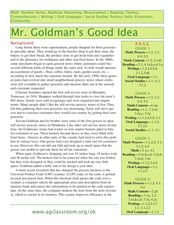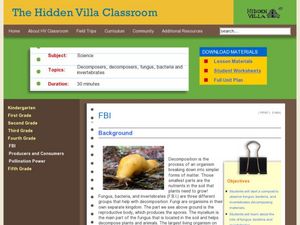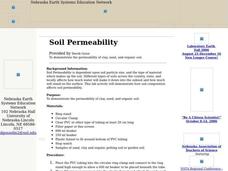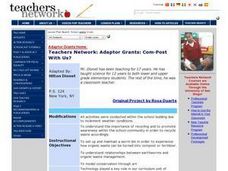Curated OER
Getting the Dirt on Soils
Students examine soils and the components that make them up. In this hands-on soil science activity, students receive soil samples and must identify the various aspect which make up soil.
Curated OER
Sunflowers, The Circle of Life
Students investigate and observe plants and animals in nature. They find out how life cycles are present in much of nature. Students use appropriate graphic organizers for information gathering. Students use sequence life cycles of...
Curated OER
Nitrogen Fixation, OR What a Gas!
Students illustrate the adaptation and co-evolution of organisms. They examine set up an experiment to determine the effect of adding the Rhizobium bacteria to a group of legume seeds.
Curated OER
Celebrating Chinese Culture: Legends & Myths, Chinese New Year, Customs & Traditions
Students read books about other cultures and explore their customs and traditions. They discuss the meanings of myths and legends and then brainstorm examples of stories that fit the description. Students experience hands-on activities...
Curated OER
Food Chains And Webs
Students investigate the concept of soil and all its components. They collect samples from a local site and transplant it into a terrarium. Students identify the organic elements, clay ,silt, and other forms of debris. They also identify...
Curated OER
Lesson Two: Discover a purpose for keywords
Second graders research a topic in nature. In this research activity, 2nd graders pick a nature topic and discuss the keywords needed to find more information about that topic. They fill their information out on a organizer.
Curated OER
Martha Who?
Students explore how the number and types of organisms an ecosystem can support depends on the resources available and on abiotic factors, such as quantities of light and water, a range of temperatures, soil composition. They are...
Curated OER
Butterfly Metamorphosis
Young scholars read a story, watch a video, and interact with a butterfly website to learn about butterfly metamorphosis. In this butterfly lesson plan, students listen, discuss, and participate in activities relating the metamorphosis...
Curated OER
Mr. Goldman's Good Idea
Shopping carts are a modern convenience that many people take for granted. Make sure your pupils do not fall into that category by completing the activities in this plan. There are ideas included for language arts, social studies, math,...
Curated OER
FBI
Fourth graders experiment with compost. In this Science activity, 4th graders begin a worm compost as well as an outdoor compost. Students discuss decomposition.
Curated OER
Homonyms- Quiz 28
Students examine the use of homonyms in sentences. Learners read a sentence online and choose the correct homonym from the answer choices. Students click on the answer box to see the correct answer.
Curated OER
How a Seed Grows: And Who Grows It
Second graders explore botany by viewing video clips in class. For this seed growth lesson, 2nd graders identify the types of seeds that grow specific plants and what the optimal conditions are for growing seeds. Students view a video...
Curated OER
Soil Permeability
Students participate in a lab activity in which they examine the permeability of different soils. They examine the soil's composition and make predictions about the permeability of the soils. They share their observations to the class.
Curated OER
What is a Pest?
Young scholars investigate whether rabbits should be considered pests even though they make good pets. They extend this to determine what, when, and where other organisms are considered to be pests, and examine why the concept of a pest...
Curated OER
The Scoop on Summer
Third graders write a noun that names a place they spent their summer vacation, a verb telling one activity they did, and use those words to write a complete sentence. Finally, they use an ice cream cone graphic organizer as a guide to...
Curated OER
Biotic Factors
Students identify individual organism, a species, and a population within the study community. They identify biotic factors at the site and attempt to characterize the site's species diversity.
Curated OER
Our Environment
Pupils engage in a literature study that helps students to connect with some of the issues of conservation. They list parts of the environment that need protection with the help of a graphic organizer. Then pupils discuss in groups why...
Curated OER
Com-Post With Us?
Students discuss the importance of reducing, recycling and reusing materials to help the environment. As a class, they create a worm bin and observe how it turns material in to compost. They use the internet to research the...
Curated OER
Think Green
Students experience and practice compositing and recycling through hands-on-activities. They distinguish between which items from their trash can be recycled, composted and reused. The process for making recycled paper is also covered in...
Curated OER
Survival of the Fittest
Pupils explore plant needs and growth. In this plant science lesson, students use a cereal box to complete a plant growth graph activity.
Curated OER
You Are What You Eat: Lessons from Alice Waters
Students view the AMERICAN MASTERS episode titled ALICE WATERS AND HER DELICIOUS REVOLUTION. They examine their own eating habits and determine how they can eat food that is both healthier and tastier. Through Guided Reading strategies,...
Curated OER
Two Beets Or Not Two Beets—What Is Your Question?
Students use the scientific method to test an idea regarding the structures of a plant as it supports the biological evidence for life. In this growing roots instructional activity, students use organizing sheets to record their...
Chicago Botanic Garden
Causes and Effects of Climate Change
Wrap-up a unit on global climate change with a activity that examines the causes and effects of climate change. Learners fill out a chart that represents what they think causes climate change—natural and human-based—and what they think...
Science 4 Inquiry
Introducing the Types of Energy
Young scientists explore many different types of energy including light, heat, nuclear, sound, potential, and more. They match the types of energy and identify when energy transfers from one type to another.























